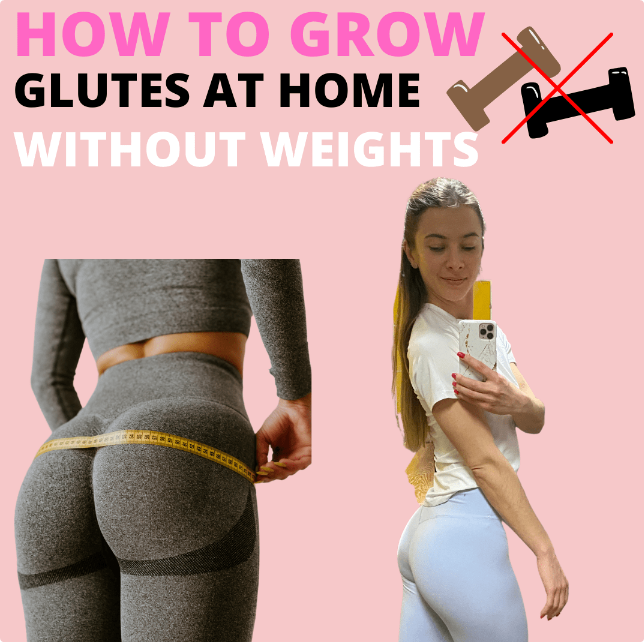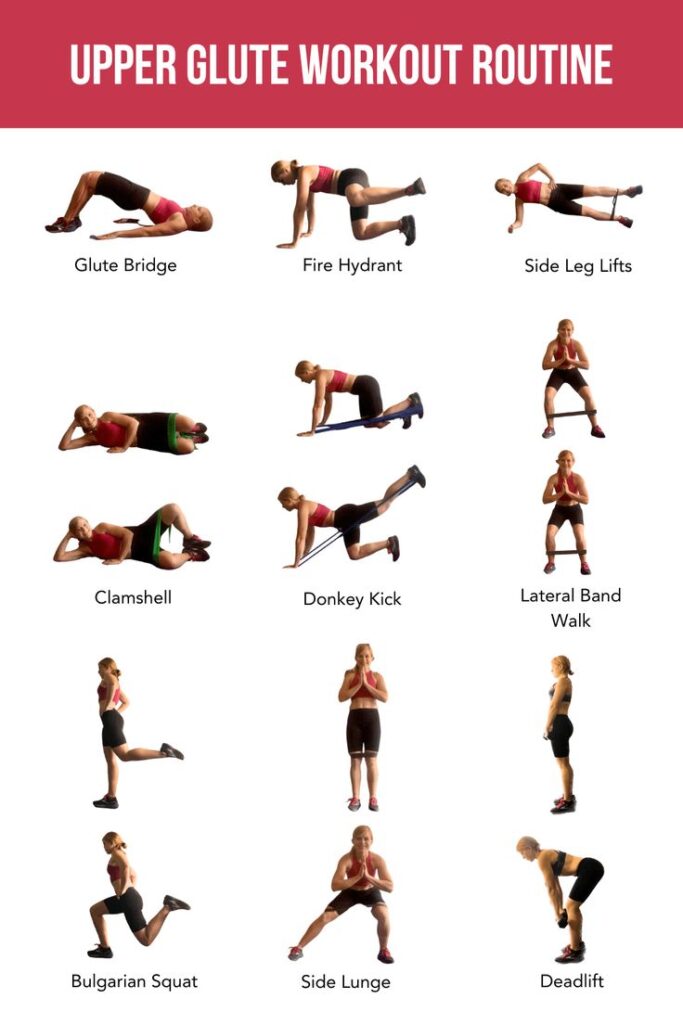Growing your glutes without gaining weight might seem like a challenging task, but it’s definitely possible!
You’ll be happy to know that there are specific exercises and techniques that can help you achieve a toned and lifted derriere while maintaining (or even reducing) your overall body weight.
How To Grow Glutes Without Gaining Weight
So, if you’ve been searching for ways to enhance your backside without adding extra pounds, you’re in the right place.
In this article, we’re going to break down the most effective strategies for growing your glutes without packing on additional weight.
We’ll cover everything from targeted workouts and muscle activation techniques to nutritional tips that’ll support your goals.
So let’s dive in and discover how you can get those enviable glutes you’ve always wanted!
Choosing the Right Exercises to Grow Glutes
When it comes to building glutes, isolation exercises are great for targeting specific muscle groups.
Compound exercises, on the other hand, involve multiple muscle groups and can help you get more bang for your buck.
As for repetitions and sets, it’s best to start with lighter weights and higher reps, then gradually increase the weight and lower the reps as you get stronger.
That way, you’ll be able to maximize your muscle growth without gaining weight.
Isolation exercises
Isolation exercises are particularly effective when paired with resistance bands, as they allow for progressive overload and can be easily adjusted to match your current strength level.
Some great isolation movements for gluteal muscles include hip thrusts, clamshells, and donkey kicks. By focusing on these specific movements, you’ll be able to engage the glutes more effectively than with compound exercises alone.
Remember that consistency is key, so be sure to incorporate these movements into your regular workout routine.
In addition to using resistance bands for progressive overload, make sure you’re also concentrating on proper form and engaging your gluteal muscles throughout each exercise.
This will help ensure that you’re targeting the right areas and getting the most out of each rep.
So go ahead, start incorporating isolation exercises into your workouts today – your glutes will thank you!
Compound exercises
While isolation exercises are fantastic for targeting specific muscles, don’t forget about the importance of compound exercises in your booty workouts.
These multi-joint movements work multiple muscle groups at once, making them an essential part of any well-rounded strength training program.
Including compound exercises in your routine not only helps promote overall muscle growth but also increases the chances of achieving those glute gains you’re after.
Some popular compound exercises that effectively engage your glutes include squats, deadlifts, and lunges.
By incorporating these movements into your regular workout regimen, you’ll be challenging your entire lower body and building a solid foundation for further glute development.
Remember to focus on proper form and technique when performing these exercises to maximize their effectiveness and reduce the risk of injury.
So go ahead and strike a balance between isolation and compound exercises in your quest for a stronger, more sculpted backside.
Your glutes will reap the benefits of this comprehensive approach to strength training and muscle growth.
Keep up the hard work, stay consistent with your workouts, and watch as those glute gains become increasingly noticeable over time!
Repetitions and sets
Now that you’ve got a good mix of isolation and compound exercises in your booty-building arsenal, it’s time to talk about repetitions and sets.
The number of reps and sets you perform for each exercise plays a crucial role in the growth of your gluteus maximus and gluteus medius muscles.
Finding the right balance between these two factors is essential for maximizing muscle development and achieving those coveted glute gains.
Typically, performing higher repetitions with lighter weights helps improve muscular endurance, while lower repetitions with heavier weights contribute to increased strength and muscle growth.
It’s important to strike a balance here, as both endurance and strength are crucial for well-rounded muscle development.
Try experimenting with different rep ranges, like 8-12 reps for 3-4 sets, or opt for a more advanced approach such as pyramid or drop sets to keep things interesting.
At the end of the day, it’s all about finding what works best for you and your individual goals.
Don’t be afraid to make adjustments along the way and remember that consistency is key when it comes to achieving those glute gains you’re after!
Implementing a Balanced Nutrition Plan
Eating variety is key when it comes to getting balanced nutrition. It’s important to pay attention to your calorie intake, too, so you don’t gain weight.
When it comes to macro-nutrients, carbohydrates, proteins, and fats should all be included in your diet. Aim to get a good balance of all three, so your body can get the right nutrients.
You also want to make sure you’re getting enough fiber, vitamins, and minerals, as well as healthy sources of fat.
By combining all these elements into your diet, you can get the nutrition you need to grow your glutes without gaining weight.
Eating variety
Incorporating different sources of protein, healthy fats, and complex carbs into your meals will not only help you reach your goals but also keep things interesting in the kitchen.
A healthy diet that supports glute growth includes plenty of protein-rich foods like lean meats, fish, legumes, and dairy products. These are crucial for muscle building and repair after a workout.
Don’t forget about adding some healthy fats to your meals as well – think avocados, nuts, seeds, and olive oil. These fats play a key role in keeping you feeling full and satisfied while supporting overall health.
In addition to proteins and healthy fats, make sure you’re getting enough complex carbohydrates from whole grains like brown rice or quinoa.
These nutrient-dense carbs not only provide the energy needed for a challenging glute workout but also assist in preventing unwanted weight gain by maintaining stable blood sugar levels throughout the day.
So go ahead and enjoy experimenting with new recipes while fueling your body with the diverse nutrients it needs to help you achieve your best-looking glutes yet!
Calorie intake
Now that we’ve covered the importance of incorporating a variety of nutritious foods into your diet, let’s talk about calorie intake and its role in glute growth.
To build lean muscle mass, it’s essential to consume enough calories to support your body’s needs during workouts and recovery. However, it’s important not to go overboard with a caloric surplus, as this can lead to unwanted weight gain.
When aiming for glute growth without gaining weight, you’ll want to find the right balance of calorie intake that allows your muscles to grow while maintaining your current weight.
This means paying close attention to how many extra calories you’re consuming each day and making adjustments as needed.
It may take some trial and error, but finding the perfect balance between what you eat and how much you exercise will be crucial in achieving your goals.
By monitoring your calorie intake closely and ensuring you’re eating a balanced diet rich in proteins, healthy fats, and complex carbohydrates, you’ll be well on your way toward reaching those glute gains without putting on unwanted pounds.
So keep experimenting with delicious recipes and fueling your workouts with the right nutrients – your hard work will surely pay off!
Macronutrient ratios
Now that you’ve got a handle on calorie intake, let’s dive into the world of macronutrient ratios and how they can help grow your glutes.
Macronutrient ratios refer to the balance of proteins, carbohydrates, and fats in your diet. Getting these ratios right is essential for muscle gains, as each macronutrient plays a vital role in the process.
To achieve your glute growth goals without gaining weight, it’s important to maintain a calorie surplus while also focusing on the right macronutrient balance. This ensures that you’re fueling your body with the necessary nutrients for resistance training and recovery.
It’s generally recommended to prioritize protein intake, as this helps build and repair muscle tissue.
Carbohydrates are also crucial for energy during workouts, while healthy fats support hormone production and overall health.
So don’t be afraid to play around with your macronutrient ratios – find what works best for your body and lifestyle.
With some experimentation and dedication, you’ll be well on your way to achieving those glorious glute gains!
Progressive Overload with Weights
To grow your glutes without gaining weight, you need to focus on increasing muscle mass through targeted exercises and consistent training.
Incorporating progressive overload into your workout routine can ensure that your glute growth will be significant and sustainable.
Progressive overload involves gradually increasing the stress placed upon the body during exercise. This can be achieved by manipulating various training variables such as:
By consistently challenging your muscles with increased demands, you’ll stimulate ongoing adaptation and growth in the targeted area – in this case, your glutes.
Prioritizing compound exercises like squats, deadlifts, and lunges with added weight will help build overall strength and muscle mass while also targeting the gluteal muscles specifically.
As you continue to use progressive overload in your workouts and see changes in your glute development, remember that it’s essential to maintain balance within your fitness routine.
While focusing on weightlifting is key for building muscle mass, incorporating cardio for fat loss is equally important to reveal those well-defined glutes underneath any excess body fat.
This balanced approach will ultimately lead to a sculpted booty that complements a strong and lean physique as a whole – all without gaining unwanted weight along the way.
So get ready for an exciting journey towards achieving those glorious glutes by combining both strength training and cardio elements seamlessly into your workout regimen!
Incorporating Cardio for Fat Loss
It’s important to find the right balance between low and high-intensity cardio to get the most out of your fat-loss goals.
Let’s talk about how to incorporate both types of cardio into your routine to help you grow your glutes without gaining weight.
Low-intensity cardio
Incorporating low-intensity cardio into your routine can help you achieve a toned gluteus minimus without gaining weight.
Low-intensity cardio exercises such as walking, cycling, or swimming are perfect for those who want to avoid a surplus of calories while still working on their glutes.
These activities allow you to burn fat and maintain muscle mass, which means your butt workouts won’t be compromised.
Plus, this type of exercise is easy on the joints and suitable for people of all fitness levels. So, next time you’re planning your workout routine, don’t forget to add some low-intensity cardio sessions.
They’ll keep you on track towards achieving that desired gluteus minimus without any unwanted weight gain. Remember, balance is key when it comes to reaching your physique goals!
High-intensity cardio
Now that we’ve talked about the benefits of low-intensity cardio for maintaining your glutes, let’s not forget about the role high-intensity cardio can play in your overall fitness journey.
High-intensity cardio is a fantastic way to burn calories quickly and effectively, which can also help you shed unwanted fat while building muscles.
This type of exercise might sound intimidating, but it’s essential for getting the most out of your workout routine.
When incorporating high-intensity cardio into your regimen, it’s vital to find a balance between burning fat and preserving muscle weight. You don’t want to lose those hard-earned butt muscles!
Some great options for high-intensity cardio include running sprints, HIIT workouts, or even plyometric exercises like jumping squats.
These activities will raise your heart rate and push your body to its limits, helping you build strength and endurance while still targeting those glutes.
So, whether you choose low or high-intensity cardio in your fitness plan, keep in mind that finding a balance is crucial to achieving the best results.
Remember to listen to your body and adjust accordingly – after all, every individual’s needs and goals are unique!
Tracking Your Progress and Adjusting Your Approach
Tracking your progress and making adjustments to your approach are essential components of successfully growing your glutes without gaining weight.
Regular progress tracking allows you to monitor your muscle growth and weight management, ensuring that you’re on the right path towards achieving your goals.
It’s important to be patient with yourself during this process, as changes may not be immediately visible.
| Positive Outcomes | Negative Outcomes |
|---|---|
| Increased muscle mass in glutes | No noticeable changes in size or shape |
| Improved strength and endurance | Unwanted weight gain |
| Enhanced self-confidence | Frustration and discouragement |
As you track your progress, take note of any patterns or areas where you might need to make adjustments in your approach.
For example, if you’re not seeing the desired muscle growth in your glutes, consider increasing the intensity or frequency of your workouts.
On the other hand, if you notice unwanted weight gain despite working hard, it might be helpful to reassess your nutrition plan or incorporate more cardio into your routine.
Remember that every individual’s journey is unique and what works for someone else may not necessarily work for you.
Stay committed to tracking your progress and remain open-minded about making necessary approach adjustments along the way.
By doing so, you’ll maximize your chances of achieving the perfect balance between glute growth and weight management – ultimately sculpting a stronger, healthier body that you can be proud of.
Frequently Asked Questions
If you still have questions about growing glutes without gaining weight, here are some of the FAQs.
Can I grow my glutes without increasing the size of my thighs or other muscle groups?
Yes, it is possible to grow your glutes without significantly increasing the size of your thighs or other muscle groups.
To achieve this, focus on exercises that specifically target the gluteal muscles, such as glute bridges, hip thrusts, and donkey kicks.
Additionally, consider incorporating resistance bands or weights to increase the intensity of these exercises without adding excessive volume to your workout routine.
Lastly, be mindful of your nutrition and ensure you’re consuming a balanced diet with adequate protein to support muscle growth while maintaining a stable overall body weight.
Are there any specific supplements or vitamins that can help with growing glutes without gaining weight?
While there aren’t any specific supplements or vitamins that solely target glute growth without contributing to overall weight gain, certain nutrients can support muscle development and recovery in general.
Consuming adequate amounts of protein, staying hydrated, and ensuring a well-rounded intake of vitamins and minerals from whole foods or supplements can contribute to overall muscle health, potentially benefiting your glutes as well.
It’s important to remember that a balanced diet, regular strength training exercises targeting the glutes, and proper rest are the primary factors in achieving glute growth without significant weight gain.
How often should I train my glutes to see optimal progress without causing muscle imbalances or overtraining?
To achieve optimal progress in glute training without causing muscle imbalances or overtraining, it’s generally recommended to train your glutes 2-3 times per week.
This frequency allows for enough stimulus for growth while also providing ample recovery time between sessions.
However, it’s essential to listen to your body and adjust your training schedule as needed, as individual responses may vary.
Additionally, incorporating a variety of exercises that target different muscle groups can help prevent imbalances and promote overall muscular development.
Can I still enjoy my favorite foods and indulge in occasional treats while working on growing my glutes without weight gain?
Yes, you can still enjoy your favorite foods and indulge in occasional treats while working on growing your glutes without weight gain.
The key is to maintain a balanced diet and practice moderation when consuming treats or high-calorie foods.
Ensure that your overall diet is rich in lean proteins, healthy fats, complex carbohydrates, and plenty of fruits and vegetables to support muscle growth and overall health.
Additionally, tracking your daily caloric intake and ensuring you’re consuming enough calories to support muscle growth but not excess weight gain can help keep you on track while allowing for the occasional indulgence.
Conclusion
In conclusion, it’s possible to grow your glutes without gaining weight or increasing the size of other muscle groups.
By focusing on targeted exercises, maintaining a balanced diet, and incorporating appropriate supplements, you can achieve your desired results while still enjoying your favorite foods in moderation.
Remember that consistency is key in seeing progress. According to the American Council on Exercise, glute exercises should be performed at least two to three times per week for optimal growth.
So keep pushing yourself and stay committed to your goals!




